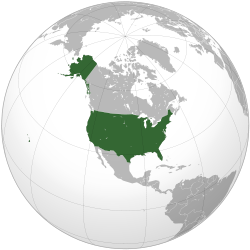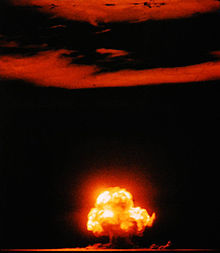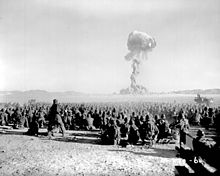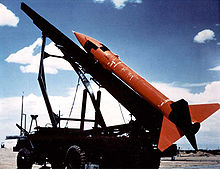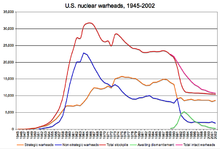- Nuclear weapons and the United States
-
United States Nuclear program start date 21 October 1939 First nuclear weapon test 16 July 1945 First fusion weapon test 1 November 1952 Last nuclear test 23 September 1992 Largest yield test 15 Mt (1 March 1954) Total tests 1,054 detonations Peak stockpile 31,255 warheads (1967)[1] Current stockpile 5,113 total[2][3] Maximum missile range 13,000 km (8,100 mi) (land)
12,000 km (7,500 mi) (sub)NPT signatory Yes (1968, one of five recognized powers) Nuclear weapons 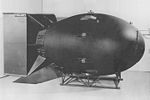
History
Warfare
Arms race
Design
Testing
Effects
Delivery
Espionage
Proliferation
Arsenals
Terrorism
Anti-nuclear oppositionNuclear-armed states United States · Russia
United Kingdom · France
China · India · Israel
Pakistan · North Korea
South Africa (former)The United States was the first country to develop nuclear weapons, and is the only country to have used them in warfare, with the separate bombings of Hiroshima and Nagasaki in World War II. Before and during the Cold War it conducted over a thousand nuclear tests and developed many long-range weapon delivery systems.[4]
Until November 1962, the vast majority of the U.S. tests were above-ground; after the acceptance of the Partial Test Ban Treaty all testing was regulated underground, in order to prevent the dispersion of nuclear fallout. Between 1940 and 1996, the U.S. spent at least $8.15 trillion in present day terms[5] on nuclear weapons development.[6] As of February 2006, over $1.2 billion in compensation was paid to U.S. citizens exposed to nuclear hazards as a result of the U.S. nuclear weapons program, and by 1998 at least $759 million was paid to the Marshallese Islanders in compensation for their exposure to U.S. nuclear testing.[7][8]
The United States currently maintains an arsenal of 5,113 warheads[2][3] and facilities for their construction and design, though many of the Cold War facilities have since been deactivated and are sites for environmental remediation.
Development history
Manhattan Project
Main article: Manhattan ProjectThe United States of America first began developing nuclear weapons during World War II under the order of President Franklin Roosevelt in 1939, motivated by a (ultimately unfounded) fear that they were engaged in a race with Nazi Germany to develop such a weapon. After a slow start under the direction of the National Bureau of Standards, at the urging of British scientists and American administrators the program was put under the Office of Scientific Research and Development, where in 1942 it was officially transferred under the auspices of the U.S. Army and became known as the Manhattan Project, an American, British and Canadian joint venture. Under the direction of General Leslie Groves, over thirty different sites were constructed for the research, production, and testing of components related to bomb making. These included the scientific laboratory Los Alamos (in New Mexico), under the direction of physicist Robert Oppenheimer, a plutonium production facility, Hanford (in Washington), and a uranium enrichment facility, Oak Ridge (in Tennessee).
By investing heavily both in breeding plutonium in early nuclear reactors, and in both the electromagnetic and gaseous diffusion enrichment processes for the production of uranium-235, the United States was able by mid-1945 to develop three usable weapons. A plutonium-implosion design weapon was tested on 16 July 1945 ("Trinity"), with around a 20 kiloton yield. On the orders of President Harry S. Truman, on 6 August of the same year a uranium-gun design bomb ("Little Boy") was used against the city of Hiroshima, Japan, and on 9 August a plutonium-implosion design bomb ("Fat Man") was used against the city of Nagasaki, Japan. The two weapons killed approximately 250,000 Japanese civilians outright, and thousands more have died over the years from radiation sickness and related cancers.
During the Cold War
Between 1945 and 1990, more than 70,000 total warheads were developed, in over 65 different varieties, ranging in yield from around .01 kilotons (such as the man-portable Davy Crockett shell) to the 25 megaton B41 bomb.[7]
Between 1940 and 1996, the U.S. spent at least $8.15 trillion in present day terms[5] on nuclear weapons development. Over half was spent on building delivery mechanisms for the weapon. $511 billion in present day terms was spent on nuclear waste management and environmental remediation.[6]
Post–Cold War
After the end of the Cold War following the dissolution of the Soviet Union in 1991, the U.S. nuclear program was heavily curtailed, halting its program of nuclear testing, ceasing in the production of new nuclear weapons, and reducing its stockpile by half by the mid-1990s under President Bill Clinton. Many of its former nuclear facilities were shut down, and their sites became targets of extensive environmental remediation. Much of the former efforts towards the production of weapons became involved in the program of stockpile stewardship, attempting to predict the behavior of aging weapons without using full-scale nuclear testing. Increased funding also was put into anti-nuclear proliferation programs, such as helping the states of the former Soviet Union eliminate their former nuclear sites, and assist Russia in their efforts to inventory and secure their inherited nuclear stockpile. As of February 2006, over $1.2 billion were paid under the Radiation Exposure Compensation Act of 1990 to U.S. citizens exposed to nuclear hazards as a result of the U.S. nuclear weapons program, and by 1998 at least $759 million was paid to the Marshallese Islanders in compensation for their exposure to U.S. nuclear testing, and over $15 million was paid to the Japanese government following the exposure of its citizens and food supply to nuclear fallout from the 1954 "Bravo" test.[7][8]
In 1998, the country spent an estimated total of $35,100,000,000 on its nuclear weapons and weapons -related programs.[9]
During the presidency of George W. Bush, and especially after the 11 September terrorist attacks of 2001, rumors have circulated in major news sources that the U.S. has been considering design of new nuclear weapons ("bunker-busting nukes"), and potentially the resumption of nuclear testing for reasons of stockpile stewardship, and non-nuclear missile defense has received additional funding as well. Statements by the U.S. government in 2004, however, imply that by 2012 the arsenal will drop to around 5,500 total warheads.[10] According to recent reports, much of that reduction was already accomplished by January 2008.[11]
Nuclear weapons testing
Main article: Nuclear weapons testingSee also: List of nuclear weapons tests of the United StatesBetween 16 July 1945 and 23 September 1992, the United States maintained a program of vigorous nuclear testing, with the exception of a moratorium between November 1958 and September 1961. A total of (by official count) 1,054 nuclear tests and two nuclear attacks were conducted, with over 100 of them taking place at sites in the Pacific Ocean, over 900 of them at the Nevada Test Site, and ten on miscellaneous sites in the United States (Alaska, Colorado, Mississippi, and New Mexico).[12] Until November 1962, the vast majority of the U.S. tests were atmospheric (that is, above-ground); after the acceptance of the Partial Test Ban Treaty all testing was regulated underground, in order to prevent the dispersion of nuclear fallout.
The U.S. program of atmospheric nuclear testing exposed a number of the population to the hazards of fallout. Estimating exact numbers, and the exact consequences, of people exposed has been medically very difficult, with the exception of the high exposures of Marshallese Islanders and Japanese fisherman in the case of the "Castle Bravo" incident in 1954. A number of groups of U.S. citizens — especially farmers and inhabitants of cities downwind of the Nevada Test Site and U.S. military workers at various tests — have sued for compensation and recognition of their exposure, many successfully. The passing of the Radiation Exposure Compensation Act of 1990 allowed for a systematic filing of compensation claims in relation to testing as well as those employed at nuclear weapons facilities. As of June 2009 over $1.4 billion dollars total has been given in compensation, with over $660 million going to "downwinders".[13]
A few notable U.S. nuclear tests include:
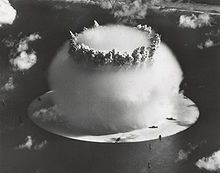 Shot "Baker" of Operation Crossroads (1946) was the first underwater nuclear explosion.
Shot "Baker" of Operation Crossroads (1946) was the first underwater nuclear explosion.
- The "Trinity" test on 16 July 1945, was the first-ever test of a nuclear weapon (yield of around 20 kt).
- The Operation Crossroads series in July 1946, was the first postwar test series and one of the largest military operations in U.S. history.
- The Operation Greenhouse shots of May 1951 included the first boosted fission weapon test ("Item") and a scientific test which proved the feasibility of thermonuclear weapons ("George").
- The "Ivy Mike" shot of 1 November 1952, was the first full test of a Teller-Ulam design "staged" hydrogen bomb, with a yield of 10 megatons. It was not a deployable weapon, however — with its full cryogenic equipment it weighed some 82 tons.
- The "Castle Bravo" shot of 1 March 1954, was the first test of a deployable (solid fuel) thermonuclear weapon, and also (accidentally) the largest weapon ever tested by the United States (15 megatons). It was also the single largest U.S. radiological accident in connection with nuclear testing. The unanticipated yield, and a change in the weather, resulted in nuclear fallout spreading eastward onto the inhabited Rongelap and Rongerik atolls, which were soon evacuated. Many of the Marshall Islands natives have since suffered from birth defects and have received some compensation from the federal government. A Japanese fishing boat, the Fifth Lucky Dragon, also came into contact with the fallout, which caused many of the crew to grow ill; one eventually died.
- Shot "Argus I" of Operation Argus, on 27 August 1958, was the first detonation of a nuclear weapon in outer space when a 1.7-kiloton warhead was detonated at 200 kilometers' altitude during a series of high altitude nuclear explosions.
- Shot "Frigate Bird" of Operation Dominic I on 6 May 1962, was the only U.S. test of an operational ballistic missile with a live nuclear warhead (yield of 600 kilotons), at Christmas Island. In general, missile systems were tested without live warheads and warheads were tested separately for safety concerns. In the early 1960s, however, there mounted technical questions about how the systems would behave under combat conditions (when they were "mated", in military parlance), and this test was meant to dispel these concerns. However, the warhead had to be somewhat modified before its use, and the missile was only a SLBM (and not an ICBM), so by itself it did not satisfy all concerns.[14]
- Shot "Sedan" of Operation Storax on 6 July 1962 (yield of 104 kilotons), was an attempt at showing the feasibility of using nuclear weapons for "civilian" and "peaceful" purposes as part of Operation Plowshare. In this instance, a 1280-feet-in-diameter and 320-feet-deep crater was created at the Nevada Test Site.
Delivery systems
Main article: Nuclear weapons delivery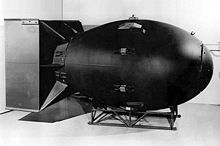 Early weapons models, such as the "Fat Man" bomb, were extremely large and difficult to use.
Early weapons models, such as the "Fat Man" bomb, were extremely large and difficult to use.
The original weapons ("Little Boy" and "Fat Man") developed by the United States during the Manhattan Project were relatively large (the latter had a diameter of 5 feet) and heavy (around 5 tons each) weapons which required specially modified bomber planes to be adapted for their bombing missions against Japan, each of which could only carry one such weapon and only within a limited range. After these initial weapons, a considerable amount of money and research was conducted towards the goal of standardizing ("G.I. proofing") nuclear warheads (so that they did not require highly specialized experts to assemble them before use, as in the case with the idiosyncratic wartime devices) and miniaturization of the warheads for use in more variable delivery systems.
Through the aid of brainpower acquired through Operation Paperclip at the tail end of the European branch of World War II, the United States was able to embark on an ambitious program in rocketry. One of the first products of this was the development of rockets capable of holding nuclear warheads. The MGR-1 Honest John was the first of such weapons, developed in 1953 as a surface-to-surface missile with a 15 mile/25 kilometer maximum range. Because of their limited range, their potential use was heavily constrained (they could not, for example, threaten Moscow with an immediate strike).
Development of long-range bombers, such as the B-29 Superfortress, during World War II was continued during the Cold War period. The B-52 Stratofortress in particular was able by the mid-1950s to carry a wide arsenal of nuclear bombs, each with different capabilities and potential use situations. Starting in 1946, the U.S. based its initial deterrence force on the Strategic Air Command, which, by the late 1950s maintained a number of nuclear-armed bombers in the sky at all times, prepared to receive orders to attack the USSR whenever needed. This system was, however, tremendously expensive, both in terms of natural and human resources, and raised the possibility of an accidental nuclear war.
During the 1950s and 1960s, elaborate computerized early warning systems such as Defense Support Program were developed to detect incoming Soviet attacks and to coordinate response strategies. During this same period, intercontinental ballistic missile (ICBM) systems were developed which could deliver a nuclear payload across vast distances, allowing the U.S. to house nuclear forces capable of hitting the Soviet Union in the American Midwest. Shorter-range weapons, including small "tactical" weapons, were fielded in Europe as well, including nuclear artillery and man-portable Special Atomic Demolition Munition. The development of submarine launched ballistic missile (SLBM) systems allowed for hidden nuclear submarines to covertly launch missiles at distant targets as well, making it virtually impossible for the Soviet Union to successfully launch a first strike attack against the United States which would not guarantee a deadly response.
Improvements in warhead miniaturization in the 1970s and 1980s allowed for the development of MIRVs — missiles which could carry multiple warheads, each of which could be separately targetable. The question of whether these missiles should be based on constantly rotating train tracks (so as to avoid being easily targeted by opposing Soviet missiles) or based in heavily fortified silos (to possibly withstand a Soviet attack) was a major political controversy in the 1980s (eventually the silos won out). MIRVed systems allowed the U.S. to make the Soviet missile defense economically unfeasible, as each offensive missile would require between three and ten defensive missiles to counter.
Additional developments in weapons delivery included cruise missile systems, which allowed a plane to fire a long-distance, low-flying nuclear-tipped missile towards a target from a relatively comfortable distance. This innovation would make missile defense additionally difficult, if not impossible.

The current delivery systems of the U.S. makes virtually any part of the Earth's surface within the reach of its nuclear arsenal. Though its land-based missile systems have a maximum range of 10,000 kilometers (less than worldwide), its submarine-based forces extend its reach from a coastline 12,000 kilometers inland. Additionally, in-flight refueling of long-range bombers and the use of aircraft carriers extends the possible range virtually indefinitely.
Public reactions
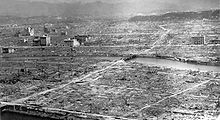 Since the atomic bombings of Hiroshima and Nagasaki, nuclear weapons have remained highly controversial and contentious objects in the forum of public debate.
Since the atomic bombings of Hiroshima and Nagasaki, nuclear weapons have remained highly controversial and contentious objects in the forum of public debate.
From the public debut of nuclear weapons during the atomic bombings of Hiroshima and Nagasaki, they were a highly controversial technology among the citizens of the United States. While it appears that most Americans in the postwar period believed that they had, as claimed by the government, hastened the end of the war with Japan, even at that early period there were questions about the ethics of their use. In the immediate postwar period, much of the public debate was on the question of whether or not the U.S. should attempt to have a monopoly on the weapons — potentially encouraging a nuclear arms race — or whether or not it should relinquish them to an intergovernmental body (such as the newly created United Nations) or contribute to some other form of international control or information dispersal. According to the historian of science Spencer Weart, it was not until the development of multi-megaton hydrogen bombs in the 1950s that a belief that nuclear weapons could potentially end all life on the planet (especially through means of nuclear fallout, highlighted by the "Castle Bravo" accident) became common in American thought or cultural expression. For the most part, however, the vast majority of American citizens believed during this time that nuclear weapons were necessary in order to ward off the threat from the Soviet Union.
 The now-familiar peace symbol was developed (in the United Kingdom) as the logo for the Campaign for Nuclear Disarmament, and was taken up enthusiastically by anti-nuclear protesters in the U.S. during the 1960s.
The now-familiar peace symbol was developed (in the United Kingdom) as the logo for the Campaign for Nuclear Disarmament, and was taken up enthusiastically by anti-nuclear protesters in the U.S. during the 1960s.
During the 1960s, following the rise of political activism in the civil rights movement, the controversy over the Vietnam War, and the beginnings of the environmentalism movement, public anxiety related to nuclear weapons began to rise to the point of direct protest. While there is little evidence that these sentiments were felt or expressed by any more than a minority of the U.S. population, their expression became increasingly amplified, especially in relation to the health hazards of nuclear testing. After the cessation of American atmospheric nuclear testing, however, the sentiment against nuclear weapons in general lost much of its momentum. During the period of détente in the 1970s, marked by weapons reduction and restriction treaties between the U.S. and the USSR, much of the anxiety over nuclear weapons in the populace and activists was transferred towards protesting civilian nuclear power plants, according to Spencer Weart's analysis.
During the presidency of Ronald Reagan in the 1980s, public anti-nuclear weapons sentiment reached its highest point, spurred by the administration's strong anti-Soviet rhetoric, Strategic Defense Initiative, and apparent reinvigoration of the arms race. On June 12, 1982, one million people demonstrated in New York City's Central Park against nuclear weapons and for an end to the cold war arms race. It was the largest anti-nuclear protest and the largest political demonstration in American history.[15][16] International Day of Nuclear Disarmament protests were held on June 20, 1983 at 50 sites across the United States.[17][18] There were many Nevada Desert Experience protests and peace camps at the Nevada Test Site during the 1980s and 1990s.[19][20]
With the fall of the Soviet Union in 1991 and the cessation of the arms race, U.S. public attitudes towards nuclear weapons became less polarized on the whole. Following the 9/11 attacks of 2001, however, concerns over whether the U.S. should develop new weapons have reinvigorated some of the older debates over their practicality, morality, and danger. The debate over the ethical implications of the bombing of Hiroshima and Nagasaki, begun in private amongst scientists and statesmen during the war, has continued to this day, in the general public as well as amongst historians, military experts, and other scholars.
Accidents
Main article: Nuclear and radiation accidents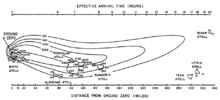 The Castle Bravo fallout plume spread dangerous levels of radioactive material over an area over 100 miles (160 km) long, including inhabited islands, in the largest single U.S. nuclear accident.
The Castle Bravo fallout plume spread dangerous levels of radioactive material over an area over 100 miles (160 km) long, including inhabited islands, in the largest single U.S. nuclear accident.
The United States nuclear program has, since its inception, suffered from a number of accidents of varying forms, ranging from single-casualty research experiments (such as that of Louis Slotin during the Manhattan Project), to the nuclear fallout dispersion of the "Castle Bravo" shot in 1954, to the accidental dropping of nuclear weapons from aircraft ("broken arrows"). How close any of these accidents came to being "major" nuclear disasters is a matter of technical and scholarly debate and interpretation.
Weapons accidentally dropped by the United States include incidents near Atlantic City, New Jersey (1957), Savannah, Georgia (1958) (see Tybee Bomb), Goldsboro, North Carolina (1961), off the coast of Okinawa (1965), in the sea near Palomares, Spain (1966, see 1966 Palomares B-52 crash), and near Thule Air Base, Greenland (1968) (see 1968 Thule Air Base B-52 crash). In some of these cases (such as Palomares), the explosive system of the fission weapon discharged, but did not trigger a nuclear chain reaction (safety features prevent this from easily happening), but did disperse hazardous nuclear materials across wide areas, necessitating expensive cleanup endeavors. Eleven American nuclear warheads are thought[by whom?] to be lost and unrecovered, primarily in submarine accidents.
The nuclear testing program resulted in a number of cases of fallout dispersion onto populated areas. The most significant of these was the Castle Bravo test, which spread radioactive ash over an area of over one hundred square miles, including a number of populated islands. The populations of the islands were evacuated but not before suffering radiation burns. They would later suffer long-term effects, such as birth defects and increased cancer risk. There were also instances during the nuclear testing program in which soldiers were exposed to overly high levels of radiation, which grew into a major scandal in the 1970s and 1980s, as many soldiers later suffered from what were claimed to be diseases caused by their exposures.
Many of the former nuclear facilities (see next section) produced significant environmental damages during their years of activity, and since the 1990s have been Superfund sites of cleanup and environmental remediation. The Radiation Exposure Compensation Act of 1990 allows for U.S. citizens exposed to radiation or other health risks through the U.S. nuclear program to file for compensation and damages.
Development agencies
 The United States Atomic Energy Commission (1946-1974) managed the U.S. nuclear program after the Manhattan Project.
The United States Atomic Energy Commission (1946-1974) managed the U.S. nuclear program after the Manhattan Project.
The initial U.S. nuclear program was run by the National Bureau of Standards starting in 1939 under the edict of President Franklin Delano Roosevelt. Its primary purpose was to delegate research and dispense of funds. In 1940 the National Defense Research Committee (NDRC) was established, coordinating work under the Committee on Uranium among its other wartime efforts. In June 1941, the Office of Scientific Research and Development (OSRD) was established, with the NDRC as one of its subordinate agencies, which enlarged and renamed the Uranium Committee as the Section on Uranium. In 1941, NDRC research was placed under direct control of Vannevar Bush as the OSRD S-1 Section, which attempted to increase the pace of weapons research. In June 1942, the U.S. Army Corps of Engineers took over the project to develop atomic weapons, while the OSRD retained responsibility for scientific research.[21]
This was the beginning of the Manhattan Project, run as the Manhattan Engineering District (MED), an agency under military control which was in charge of developing the first atomic weapons. After World War II, the MED maintained control over the U.S. arsenal and production facilities and coordinated the Operation Crossroads tests. In 1946 after a long and protracted debate, the Atomic Energy Act was passed, creating the Atomic Energy Commission (AEC) as a civilian agency which would be in charge of the production of nuclear weapons and research facilities, funded through Congress, with oversight provided by the Joint Committee on Atomic Energy. The AEC was given vast powers of control over secrecy, research, and money, and could seize lands with suspected uranium deposits. Along with its duties towards the production and regulation of nuclear weapons, it additionally was in charge of stimulating development in civilian nuclear power while also regulating its safety uses. The full transference of activities was finalized in January 1947.[22]
In 1975, following the "energy crisis" of the early 1970s and public and congressional discontent with the AEC (in part because of the impossibility to be both a producer and a regulator), it was disassembled into component parts as the Energy Research and Development Administration (ERDA), which assumed most of the AEC's former production, coordination, and research roles, and the Nuclear Regulatory Commission, which assumed its civilian regulation activities.[23]
ERDA was short-lived, however, and in 1977 the U.S. nuclear weapons activities were reorganized under the Department of Energy,[24] which currently maintains such responsibilities through the semi-autonomous National Nuclear Security Administration today. Some functions have also been taken over or shared by the Department of Homeland Security in 2002. The already-built weapons themselves are in the control of the Strategic Command, which is part of the Department of Defense.
In general, these agencies served to coordinate research and build sites. They generally operated their sites through contractors, however, both private and public (for example, Union Carbide, a private company, ran Oak Ridge National Laboratory for many decades; the University of California, a public educational institution, has run the Los Alamos and Lawrence Livermore laboratories since their inception, and will joint-manage Los Alamos with the private company Bechtel as of its next contract). Funding was received both through these agencies directly, but also from additional outside agencies, such as the Department of Defense. Each branch of the military also maintained its own nuclear-related research agencies (generally related to delivery systems).
Weapons production complex
This table is not comprehensive, as numerous facilities throughout the United States have contributed to its nuclear weapons program. It includes the major sites related primarily to the U.S. weapons program (past and present), their basic site functions, and their current status of activity. Not listed are the many bases and facilities at which nuclear weapons have been deployed. In addition to deploying weapons on its own soil, during the Cold War the United States also stationed nuclear weapons in 27 foreign countries and territories, including Okinawa, Japan (during the occupation immediately following WWII)), Greenland, Germany, Taiwan, and French Morocco then independent Morocco.[25]
Site name Location Function Status Los Alamos National Laboratory Los Alamos, New Mexico Research, Design, Pit Production Active Lawrence Livermore National Laboratory Livermore, California Research and design Active Sandia National Laboratories Livermore, California; Albuquerque, New Mexico Research and design Active Hanford Site Richland, Washington Material production (Plutonium) Not active, remediation Oak Ridge National Laboratory Oak Ridge, Tennessee Material production (Uranium-235, fusion fuel), research Active to some extent Y-12 National Security Complex Oak Ridge, Tennessee Component fabrication, stockpile stewardship, uranium storage Active Nevada Test Site Near Las Vegas, Nevada Nuclear testing and nuclear waste disposal No nuclear tests since 1992, engaged in waste disposal Yucca Mountain Nevada Test Site Waste disposal (primarily power reactor) Pending Waste Isolation Pilot Plant East of Carlsbad, New Mexico Radioactive waste from nuclear weapons production Active Pacific Proving Grounds Marshall Islands Nuclear testing Not active, last test in 1962 Rocky Flats Plant Near Denver, Colorado Components fabrication Not active, remediation Pantex Amarillo, Texas Weapons assembly, disassembly, pit storage Active, esp. disassembly Fernald Site Near Cincinnati, Ohio Material fabrication (Uranium-235) Not active, remediation Paducah Plant Paducah, Kentucky Material production (Uranium-235) Active (commercial use) Portsmouth Plant Near Portsmouth, Ohio Material fabrication (Uranium-235) Active, (centrifuge), but not for weapons production Kansas City Plant Kansas City, Missouri Component production Active Mound Plant Miamisburg, Ohio Research, component production, Tritium purification Not active, remediation Pinellas Plant Largo, Florida Manufacture of electrical components Active, but not for weapons production Savannah River Site Near Aiken, South Carolina Material production (Plutonium, Tritium) Active (limited operation), remediation 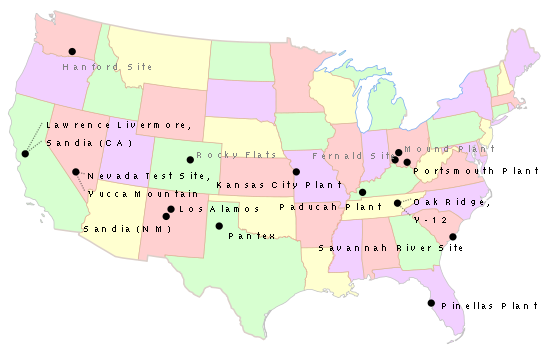
Proliferation
Main article: Nuclear proliferationEarly on in the development of its nuclear weapons, the United States relied in part on information-sharing with both the United Kingdom and Canada, as codified in the Quebec Agreement of 1943. These three parties agreed not to share nuclear weapons information with other countries without the consent of the others, an early attempt at nonproliferation. After the development of the first nuclear weapons during World War II, though, there was much debate within the political circles and public sphere of the United States about whether or not the country should attempt to maintain a monopoly on nuclear technology, or whether it should undertake a program of information sharing with other nations (especially its former ally and likely competitor, the Soviet Union), or submit control of its weapons to some sort of international organization (such as the United Nations) who would use them to attempt to maintain world peace. Though fear of a nuclear arms race spurred many politicians and scientists to advocate some degree of international control or sharing of nuclear weapons and information, many politicians and members of the military believed that it was better in the short term to maintain high standards of nuclear secrecy and to forestall a Soviet bomb as long as possible (and they did not believe the USSR would actually submit to international controls in good faith).
 The Atoms for Peace program distributed nuclear technology, materials, and know-how to many less technologically advanced countries.
The Atoms for Peace program distributed nuclear technology, materials, and know-how to many less technologically advanced countries.Since this path was chosen, the United States was, in its early days, essentially an advocate for the prevention of nuclear proliferation, though primarily for the reason originally of self-preservation. A few years after the USSR detonated its first weapon in 1949, though, the U.S. under President Dwight D. Eisenhower sought to encourage a program of sharing nuclear information related to civilian nuclear power and nuclear physics in general. The Atoms for Peace program, begun in 1953, was also in part political: the U.S. was better poised to commit various scarce resources, such as enriched uranium, towards this peaceful effort, and to request a similar contribution from the Soviet Union, who had far fewer resources along these lines; thus the program had a strategic justification as well, as was later revealed by internal memos. This overall goal of promoting civilian use of nuclear energy in other countries, while also preventing weapons dissemination, has been labeled by many critics as contradictory and having led to lax standards for a number of decades which allowed a number of other nations, such as India, to profit from dual-use technology (purchased from nations other than the U.S.).
The United States is one of the five "nuclear weapons states" permitted to maintain a nuclear arsenal under the Nuclear Non-Proliferation Treaty, of which it was an original signatory on 1 July 1968 (ratified 5 March 1970).
The Cooperative Threat Reduction program of the Defense Threat Reduction Agency was established after the breakup of the Soviet Union in 1991 to aid former Soviet bloc countries in the inventory and destruction of their sites for developing nuclear, chemical, and biological weapons, and their methods of delivering them (ICBM silos, long range bombers, etc.). Over $4.4 billion has been spent on this endeavor to prevent purposeful or accidental proliferation of weapons from the former Soviet arsenal.[26]
After India and Pakistan tested nuclear weapons in 1998, President Bill Clinton imposed economic sanctions on the countries. In 1999, however, the sanctions against India were lifted; those against Pakistan were kept in place as a result of the military government which had taken over. Shortly after the September 11 attacks in 2001, President George W. Bush lifted the sanctions against Pakistan as well, in order to get the Pakistani government's help as a conduit for US and NATO forces for operations in Afghanistan.
The U.S. government has officially taken a silent policy towards the nuclear weapons ambitions of the state of Israel, while being exceedingly vocal against proliferation of such weapons in the countries of Iran and North Korea. The same critics point out the fact that it is violating its own non-proliferation treaties in the pursuit of so-called "nuclear bunker busters". The 2003 invasion of Iraq by the U.S. was done, in part, on accusations of weapons development, and the Bush administration has said that its policies on proliferation were responsible for the Libyan government's agreement to abandon its nuclear ambitions.[27]
IAEA proposed 2005 a ban on fissile material that would greatly limit the production of weapons of mass destruction. 147 countries voted for this proposal but the United States voted against.
International relations and nuclear weapons
In 1958, the United States Air Force had considered a plan to drop nuclear bombs on China during a confrontation over Taiwan but it was overruled, previously secret documents showed after they were declassified due to the Freedom of Information Act in April 2008. The plan included an initial plan to drop 10-15 kiloton bombs on airfields in Amoy (now called Xiamen) in the event of a Chinese blockade against Taiwan's Offshore Islands.[28]
Occupational illness
The Energy Employees Occupational Illness Compensation Program (EEOICP) began on July 31, 2001. The program provides compensation and health benefits to Department of Energy nuclear weapons workers (employees, former employees, contractors and subcontractors) as well as compensation to certain survivors if the worker is already deceased.[29] As of August 14, 2010, the program had already identified 45,799 civilians who lost their health (including 18,942 who developed cancer) due to exposure to radiation and toxic substances while producing nuclear weapons for the United States.[30]
Status as of 2006
As of 2006, the United States was believed to maintain an arsenal of around 9,960 intact warheads, of which 5,735 were considered active or operational, and of these only a certain number were deployed at any given time. These broke down into 5,021 "strategic" warheads, 1,050 of which were deployed on land-based missile systems (all on Minuteman ICBMs), 1,955 on bombers (B-52, B-1B, and B-2), and 2,016 on submarines (Ohio class), according to a 2006 report by the Natural Resources Defense Council.[31] Of 500 "tactical" "nonstrategic" weapons, around 100 are Tomahawk cruise missiles and 400 are B61 bombs. A few hundred of the B61 bombs are located at seven bases in six European NATO countries (Belgium,[32] Germany,[32] Italy, the Netherlands,[32] Turkey[32] and the United Kingdom), the only such weapons in forward deployment.[33][34] The United States has considered withdrawing these nuclear weapons.[35] According to one source, the quantity of the B61 nuclear bombs is 200 in five of the six countries (excluding the United Kingdom), including 80 bombs deployed at the Incirlik Air Base in Turkey.[35]
Around 4,225 warheads have been removed from deployment but have remained stockpiled as a "responsible reserve force" on inactive status. Under the May 2002 Treaty on Strategic Offensive Reductions ("SORT"), the U.S. pledged to reduce its stockpile to 2,200 operationally deployed warheads by 2012, and in June 2004 the Department of Energy announced that "almost half" of these warheads would be retired or dismantled by then.[36]
A 2001 nuclear posture review published by the Bush administration called for a reduction in the amount of time needed to test a nuclear weapon, and for discussion on possible development in new nuclear weapons of a low-yield, "bunker-busting" design (the Robust Nuclear Earth Penetrator). Work on such a design had been banned by Congress in 1994, but the banning law was repealed in 2003 at the request of the Department of Defense. The Air Force Research Laboratory researched the concept, but the United States Congress canceled funding for the project in October 2005 at the National Nuclear Security Administration's request. According to Fred T. Jane's Information Group, the program could still continue in 2006 under a new name.
In 2006, the Bush administration also proposed the Reliable Replacement Warhead program and initiated its design and development. The program, intended to produce a simple, reliable, long-lasting, and low-maintenance future nuclear force for the United States, encountered opposition due to the obligations of the United States under Article VI of the Nuclear Non-Proliferation Treaty, which the United States has signed, ratified, and is bound by, and which obligates the five nuclear weapons states who are bound by it (of which the United States is such a state) to work in good faith towards nuclear disarmament.
The Reliable Replacement Warhead was designed to replace the aging W76 warhead currently in a life-extension program. It was to incorporate a well-tested and verified primary SKUA9 and a new fusion secondary. The device would be built much much more robustly than its predecessors and should require longer periods between service and replacement. It will use insensitive high explosives, which are virtually impossible to detonate without the right mechanism. The new insensitive explosives can hit a concrete wall at Mach 4 and still not detonate. The device would also use a heavy radiation case for reliability. Since this weapon will supposedly never be tested via detonation, as has every weapon presently in the US arsenal, some fear that either the weapon will not be reliable, or will require testing to confirm its reliability, breaking the moratorium that has been observed by the recognized nuclear powers (the recognized nuclear powers include the US, Russia, the UK, the PRC, and France; they do not include the generally-recognized but undeclared Israel, nor the declared but unrecognized India, Pakistan, and North Korea) and was disliked by several elements of the Bush Administration, who believed nuclear tests ought to be conducted routinely; indeed, the Reliable Replacement Warhead was seen as the first step in the implementation of the US nuclear weapons laboratories' plan, called "Complex 2030", to rebuild dismantled nuclear weapons infrastructure so as to ensure that nuclear weapon design continues to be a field of research in the US through the mid-point of the 21st century.
In 2005 the U.S. revised its declared nuclear political strategy, the Doctrine for Joint Nuclear Operations, to emphasize the possibility of the use of nuclear weapons preemptively against an adversary possessing weapons of mass destruction or overwhelming conventional forces. Whether the Single Integrated Operational Plan ("SIOP") has been revised accordingly is uncertain, but possible.
Current status
The United States is one of the five recognized nuclear powers under the Nuclear Non-Proliferation Treaty ("NPT"). As of September 2009[update] it possessed 5,113 warheads operationally deployed, in active reserve, or held in inactive storage. This figure compares to a peak of 31,225 total warheads in 1967 and 22,217 in 1989, and does not include "several thousand" warheads that have been retired and scheduled for dismantlement.[2][3]
In 2009 and 2010, the administration of Barack Obama declared policies that would invalidate the Bush-era policy for use of nuclear weapons and its motions to develop new ones. First, in a prominent 2009 speech, U.S. president Barack Obama outlined a goal of "a world without nuclear weapons".[37] To that goal, U.S. President Barack Obama and Russian President Dmitry Medvedev signed a new START treaty on April 8, 2010 to reduce the number of active nuclear weapons from 2,200 to 1,550.[38][39] That same week Obama also revised U.S. policy on the use of nuclear weapons in a Nuclear Posture Review required of all presidents, declaring for the first time that the U.S. would not use nuclear weapons against nonnuclear, NPT-compliant states. The policy also renounces development of any new nuclear weapons.[40]
The Obama Administration, in its release of the 2012 defense budget, included plans to modernize the nation's nuclear weapons arsenal, as well as maintain.[41]
United States strategic nuclear weapons arsenal
Operational American strategic nuclear forces, 2009[42] Delivery Vehicles Warheads Minuteman III W78/Mk12A 250 350 Minuteman III W87/Mk21 200 200 ICBM (total) 450 550 UGM-133A Trident II D-5 W76-0/Mk4 288 718 UGM-133A Trident II D-5 W76-1/Mk4A 50 UGM-133A Trident II D-5 W88/Mk5 384 SLBM (total) 288 1,152 B-2 20 na B-52H 93 na B61-7 na 150 B61-11 na B83 na ALCM/W80-1 na 350 Bomber force (total) 113 500 Strategic forces (total) 851 2,200 See also
- United States and weapons of mass destruction
- History of nuclear weapons
- National Security Strategy of the United States
- United States Strategic Command
- List of nuclear tests
- Nuclear-free zone
- Global Security Institute
- Anti-nuclear movement in the United States
Notes
- ^ http://www.defense.gov/npr/docs/10-05-03_Fact_Sheet_US_Nuclear_Transparency__FINAL_w_Date.pdf
- ^ a b c Arshad Mohammed and Phil Stewart (2010-05-03). "U.S. says nuclear arsenal includes 5,113 warheads". Reuters. http://www.reuters.com/article/idUSTRE64251X20100503?feedType=RSS&feedName=topNews. Retrieved 2010-05-03.
- ^ a b c Anthony Capaccio and Viola Gienger (2010-05-03). "U.S. Discloses Arsenal of 5,113 Nuclear Warheads". Bloomberg. http://www.businessweek.com/news/2010-05-03/u-s-discloses-arsenal-of-5-113-nuclear-warheads-update1-.html. Retrieved 2010-05-03.
- ^ According to Carey Sublette's Nuclear Weapon Archive, the United States "conducted (by official count) 1054 nuclear tests" between 1945 and 1992.
- ^ a b Consumer Price Index (estimate) 1800–2008. Federal Reserve Bank of Minneapolis. Retrieved December 7, 2010.
- ^ a b Brookings Institution, "Estimated Minimum Incurred Costs of U.S. Nuclear Weapons Programs, 1940-1996", at http://www.brook.edu/fp/projects/nucwcost/figure1.htm
- ^ a b c Brookings Institution, "50 Facts About Nuclear Weapons", at http://www.brook.edu/FP/PROJECTS/NUCWCOST/50.HTM
- ^ a b "Radiation Exposure Compensation System Claims to Date Summary of Claims Received", updated regularly at http://www.usdoj.gov/civil/omp/omi/Tre_SysClaimsToDateSum.pdf
- ^ 50 Facts About U.S. Nuclear Weapons - Brookings Institution
- ^ Norris, Robert S.; Hans M. Kristensen (September/October 2007). "The U.S. stockpile, today and tomorrow". Bulletin of the Atomic Scientist 63 (5): 60–63. doi:10.2968/063005013. http://thebulletin.metapress.com/content/3605g0m20h18877w/fulltext.pdf. Retrieved 5 May 2009.[dead link]
- ^ Norris, Robert S.; Hans M. Kristensen (March/April 2008). "U.S. nuclear forces, 2008". Bulletin of the Atomic Scientists 64 (1): 50–53. doi:10.2968/064001012. http://thebulletin.metapress.com/content/pr53n270241156n6/fulltext.pdf. Retrieved 5 May 2009.[dead link]
- ^ Carey Sublette, "Gallery of U.S. Nuclear Tests", online at http://nuclearweaponarchive.org/Usa/Tests/
- ^ Radiation Exposure Compensation System: Claims to Date Summary of Claims Received by 06/11/2009
- ^ MacKenzie, Donald A. (1993). Inventing Accuracy: A Historical Sociology of Nuclear Missile Guidance. Cambridge, Massachusetts: MIT Press. pp. 343–344. ISBN 978-0-262-63147-1.
- ^ Jonathan Schell. The Spirit of June 12 The Nation, July 2, 2007.
- ^ 1982 - a million people march in New York City
- ^ Harvey Klehr. Far Left of Center: The American Radical Left Today Transaction Publishers, 1988, p. 150.
- ^ 1,400 Anti-nuclear protesters arrested Miami Herald, June 21, 1983.
- ^ Robert Lindsey. 438 Protesters are Arrested at Nevada Nuclear Test Site New York Times, February 6, 1987.
- ^ 493 Arrested at Nevada Nuclear Test Site New York Times, April 20, 1992.
- ^ "Henry DeWolf Smyth Papers, American Philosophical Society". Amphilsoc.org. Archived from the original on May 11, 2008. http://web.archive.org/web/20080511094050/http%3A//www.amphilsoc.org/library/mole/s/smythoverview.htm. Retrieved 2009-06-21.
- ^ "DOE Office of Science — Chicago Office". Ch.doe.gov. http://www.ch.doe.gov/html/site_info/atomic_energy.htm. Retrieved 2009-06-21.
- ^ "DOE Office of Science — Chicago Office". Ch.doe.gov. http://www.ch.doe.gov/html/site_info/energy_research.htm. Retrieved 2009-06-21.
- ^ "DOE Office of Science — Chicago Office". Ch.doe.gov. 2004-04-01. http://www.ch.doe.gov/html/site_info/department_energy.htm. Retrieved 2009-06-21.
- ^ "United States Secretly Deployed Nuclear Bombs In 27 Countries and Territories During Cold War". National Security Archive. 1999-10-20. http://www.gwu.edu/~nsarchiv/news/19991020/index.html. Retrieved 2006-08-06.
- ^ [1][dead link]
- ^ "President Bush: Libya Pledges to Dismantle WMD Programs". Georgewbush-whitehouse.archives.gov. 2003-12-19. http://georgewbush-whitehouse.archives.gov/news/releases/2003/12/20031219-9.html. Retrieved 2009-06-21.
- ^ Apr 30, 2008 (2008-04-30). "US Air Force planned nuclear strike on China over Taiwan: report". Afp.google.com. http://afp.google.com/article/ALeqM5jujIhYgbkZqmcHmmcXzVQiivkwVA. Retrieved 2009-06-21.
- ^ Energy Employees Occupational Illness Compensation Program
- ^ EEOICPA Combined Program Statistics
- ^ Norris, Robert S.; Hans M. Kristensen (January/February 2006). "U.S. nuclear forces, 2006". Bulletin of the Atomic Scientists 62 (1): 68–71. doi:10.2968/062001020. http://thebulletin.metapress.com/content/j8v4421j728q2v76/fulltext.pdf. Retrieved 5 May 2009.[dead link]
- ^ a b c d Murphy, Philip D. (12 November 2009). "NATIONAL SECURITY ADVISOR HEUSGEN ON AFGHANISTAN, MIDDLE EAST, IRAN, DETAINEES, RUSSIA, NUKES AND BALKANS". Cablegate. Wikileaks. Archived from the original on 30 November 2010. http://www.webcitation.org/5udZJ4Ro6. Retrieved 30 November 2010. "a withdrawal of nuclear weapons from Germany and perhaps from Belgium and the Netherlands could make it very difficult politically for Turkey to maintain its own stockpile"
- ^ "United States Still Deploys Some 480 nuclear weapon in Europe, report finds". Natural Resources Defense Council. February 9, 2005. http://www.nrdc.org/media/pressReleases/050209.asp. Retrieved 2006-08-06.
- ^ "United States Removes Nuclear Weapons From German Base, Documents Indicate". Federation of American Scientists. http://www.fas.org/blog/ssp/2007/07/united_states_removes_nuclear.php. Retrieved 2007-07-10.
- ^ a b "Report: US considers withdrawing nuclear bombs from Turkey," Today's Zaman. April 03, 2010.
- ^ "Country Overview: United States: Profile". Nuclear Threat Initiative. May 2006. http://www.nti.org/e_research/profiles/USA/index.html. Retrieved 2006-08-06.
- ^ "Obama sets goal of world without nuclear weapons — World Politics, World". London: The Independent. 3 April 2009. http://www.independent.co.uk/news/world/politics/obama-sets-goal-of-world-without-nuclear-weapons-1661727.html. Retrieved 2009-06-21.
- ^ ["http://www.npr.org/templates/story/story.php?storyId=106292556 "U.S., Russia Agree To Pursue Nuclear Reduction"]. "http://www.npr.org/templates/story/story.php?storyId=106292556.
- ^ Michael D. Shear (8 April 2010). "Obama, Medvedev sign treaty to reduce nuclear weapons". The Washington Post. http://www.washingtonpost.com/wp-dyn/content/article/2010/04/08/AR2010040801677.html. Retrieved 9 April 2010.
- ^ David E. Sanger; Peter Baker (5 April 2010). "Obama Limits When U.S. Would Use Nuclear Arms". New York Times. http://www.nytimes.com/2010/04/06/world/06arms.html. Retrieved 8 April 2010.
- ^ Hans Kristensen (17 February 2011). "The Nuclear Weapons Modernization Budget". FAS Strategic Security Blog. Federation of American Scientists. http://www.fas.org/blog/ssp/2011/02/nuclearbudget.php. Retrieved 23 February 2011.
- ^ - US Nuclear Forces 2009
References
- Hacker, Barton C. Elements of Controversy: The Atomic Energy Commission and Radiation Safety in Nuclear Weapons Testing, 1947-1974. Berkeley, CA: University of California Press, 1994. ISBN 978-0-520-08323-3
- Hansen, Chuck. U.S. Nuclear Weapons: The Secret History. Arlington, TX: Aerofax, 1988. ISBN 978-0-517-56740-1
- MacKenzie, Donald A. Inventing Accuracy: A Historical Sociology of Nuclear Missile Guidance. Cambridge, MA: MIT Press, 1990. ISBN 978-0-262-13258-9
- Schwartz, Stephen I. Atomic Audit: The Costs and Consequences of U.S. Nuclear Weapons. Washington, D.C.: Brookings Institution Press, 1998. http://www.brook.edu/FP/PROJECTS/NUCWCOST/WEAPONS.HTM ISBN 978-0-8157-7773-1
- Weart, Spencer R. Nuclear Fear: A History of Images. Cambridge, MA: Harvard University Press, 1985. ISBN 978-0-674-62835-9
- Biello,David."A Need for New Warheads?" Scientific American, November 2007
External links
- Video archive of US Nuclear Testing at sonicbomb.com
- U.S. Nuclear Forces 2006 Robert S. Norris and Hans M. Kristensen Bulletin of the Atomic Scientists, January/February 2006
- Nuclear Threat Initiative: United States
- NDRC's data on the US Nuclear Stockpile, 1945-2002
- GlobalSecurity.org, esp. facilities, forces, and operations
- Nuclear Weapons Archive, esp. nuclear tests and U.S. Arsenal, Past and Present
- US Doctrine for Joint Nuclear Operations
- Comment matrix on Doctrine for Joint Nuclear Operations
- Snapshot of the U.S. Nuclear Weapons Complex, April 2004 by the Los Alamos Study Group
- 20 Mishaps That Might Have Started Accidental Nuclear War A somewhat chilling list of the closest calls so far.
- US Nuclear Weapons Accidents list published by the Center for Defense Information ( CDI)
- Putin: U.S. pushing others into nuclear ambitions (February 2007)
- New nuclear warhead design for US
- U.S. government settles on design for new nuclear warheads
- Annotated bibliography of U. S. nuclear weapons programs from the Alsos Digital Library for Nuclear Issues
- US announces plans to build new nuclear warheads
- Trends in U.S. Nuclear Policy - analysis by William C. Potter, IFRI Proliferation Papers n°11, 2005
- US Nuclear Strategy After the 2008 Presidential Elections, Analysis by Calin Trenkov-Wermuth, August 2008, European Union Institute for Security Studies
- Annotated bibliography for U.S. nuclear weapons programs from the Alsos Digital Library for Nuclear Issues
Manhattan Project Sites 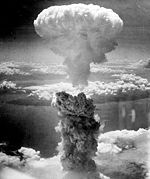
Administrators Vannevar Bush · James Conant · Thomas Farrell · Leslie Groves · Franklin Matthias · Kenneth Nichols · Robert Oppenheimer · William ParsonsScientists Hans Bethe · Niels Bohr · James Chadwick · Arthur Compton · Enrico Fermi · Richard Feynman · Klaus Fuchs · George Kistiakowsky · Ernest Lawrence · William Penney · Emilio G. Segrè · Glenn T. Seaborg · Leó Szilárd · Edward Teller · Richard C. Tolman · Stanislaw Ulam · Harold Urey · Leona Woods · Chien-Shiung WuRelated articles Timeline · History of nuclear weapons · Nuclear weapons and the United States · S-1 Uranium Committee · Chicago Pile-1 · X-10 Graphite Reactor · Y-12 National Security Complex · Operation Alsos · Smyth Report · Project Alberta · 509th Operations Group · Fat Man · Little Boy · Enola Gay · Bockscar · The Great Artiste · Atomic bombings of Hiroshima and Nagasaki (debate) · Atomic Spies · Atomic Energy Act of 1946 · Operation Crossroads · Tube AlloysAnti-nuclear movement in the United States General issues Anti-nuclear movement in California · Anti-nuclear groups in the United States · Anti-nuclear protests in the United States · Great Peace March for Global Nuclear Disarmament · List of cancelled nuclear plants in the United States · Nuclear power in the United States · Nuclear weapons and the United States ·
Organizations
and groupsAbalone Alliance · Clamshell Alliance · Committee for Nuclear Responsibility · Corporate Accountability International · Critical Mass · Friends of the Earth · Greenpeace USA · Institute for Energy and Environmental Research · Mothers for Peace · Musicians United for Safe Energy · Nevada Desert Experience · Nuclear Control Institute · Nuclear Information and Resource Service · Physicians for Social Responsibility · Plowshares Movement · Public Citizen · Shad Alliance · Sierra Club · Three Mile Island Alert · Women Strike for Peace ·People Daniel Berrigan · Larry Bogart · Helen Caldicott · Glenn Carroll · Barry Commoner · Frances Crowe · Carrie Barefoot Dickerson · Jane Fonda · John Gofman · Paul Gunter · John Hall · Amory Lovins · Arjun Makhijani · Gregory Minor · Ralph Nader · Linus Pauling · Eugene Rabinowitch · Bonnie Raitt · Martin Sheen · Karen Silkwood · Louie Vitale · Harvey Wasserman ·Main protest
sitesBlack Fox · Bodega Bay · Diablo Canyon · Indian Point · LLNL · Montague · Naval Base Kitsap · Nevada Test Site · Rancho Seco · Rocky Flats · San Onofre · Seabrook · Shoreham · Three Mile Island · Trojan · Vermont Yankee · Yankee RoweBooks Carbon-Free and Nuclear-Free · Conservation Fallout · Critical Masses · Fallout: An American Nuclear Tragedy · Killing Our Own · Licensed to Kill? · Making a Real Killing · Nuclear Implosions · Nuclear Politics in America · The Cult of the Atom · TMI 25 Years Later · We Almost Lost DetroitCategories:- Nuclear weapons of the United States
- Nuclear weapons program of the United States
Wikimedia Foundation. 2010.

